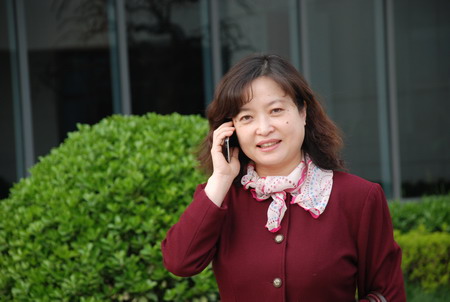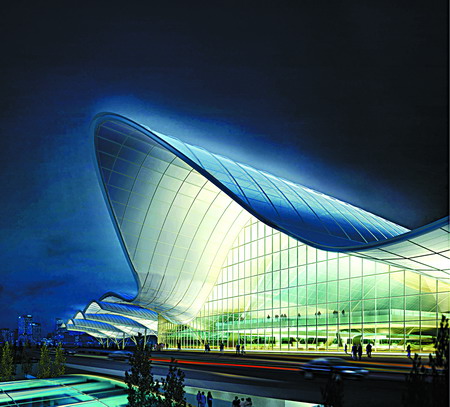Photo
Architecture important to a better life in a better city
By Wang Danna (China Daily)
Updated: 2010-04-30 08:07
 |
Large Medium Small |
 |
| Fleur des Digures, director general of AREP China. |
French architectural firm AREP, has been deeply involved in development in China over the past decade.
Fleur des Digures, director general of AREP China, spoke about AREP China's development over the past decade and the art of leadership with Beijing and Paris attaching great importance to French President Nicolas Sarkozy's three-day state visit to China starting April 28, at the occasion of the opening of the 2010 Shanghai World Expo.
Important to society
Fleur des Digures joined the company when AREP entered the Chinese market over 10 years ago and has participated in every step of its development.
AREP has created many landmark buildings in Beijing, Shanghai, Tianjin and other large cities, such as Wuhan, Chengdu and Shenzhen, including the Beijing Capital Museum, the Xizhimen Transportation Hub and Business Center, the South Shanghai Railway Station, Wuhan Railway Station and the Tianjin TEDA Financial Center.
 |
| Wuhan Railway Station |
Due to the fast pace of the Chinese construction industry, AREP has been deeply involved in China's march towards a better life for its people. AREP China's work has therefore contributed to improving urban life, echoing the Shanghai Expo theme of: "Better City, Better Life".
Fleur des Digures said she thinks buildings should use high technology but should also compliment the surrounding environment and express the regional culture. She believes every building is a book without words but with its own symbolic language.
Fleur des Digures has been at AREP for 10 years and loves her job. Her way of thinking comes partly from her mother. When encountering difficulties, Fleur des Digures is always calling her mother for help to get comfort or encouragement. Her mother once took part in some battles during the Anti-Japanese and Liberation wars, which enables her to understand life better than others.
Fleur des Digures said her mother told her success is often attributed to dedication and commitment as well as collective consciousness and capabilities of observation and analysis, which helps Fleur des Digures understand quite well with her job and her team.
"If you buy an item of clothing, you can throw it away if you don't like it. But a building will stand there no matter whether you are proud of it or ashamed of it. Architecture is a part of our history that cannot be undone. We must be very careful and spare no effort to make every project an example of unique and practical architecture."
Not every building is perfect and sometimes projects generate a mediocre result or cooperation with a partner doesn't work out. Fleur des Digures said that imperfect results "like a miniature version of society, are the first steps to success."
Respect and trust
Communicating with local municipal officials, project owners and French designers is an integral part of Fleur's job. This means that she has to learn about the urban planning of a city, the requirements of the municipal government, the practical functions of the targeted project as well as the local culture and customs. She informs her French designers of all this information.
She also has to translate her French designer's architectural language into acceptable Chinese thoughts and concepts and persuade the local officials, project owners and citizens to accept it.
Under such circumstances, Fleur des Digures often finds herself in an awkward situation. She has to negotiate a plan that will suit everybody. "According to each different situation, I have to know who the decision-maker is and where the feasibility lies."
"Learning to respect Chinese culture is always of the most importance. Not all the projects in China have been a huge success, but we try to express our design concept in language that the Chinese can fully understand," she said.
Fleur des Digures attributes AREP's success to the excellent architectural team, both the innovative French architects and the talented Chinese designers, who turn original ideas into landmark buildings.
"Our industrious and experienced team members such as Tang Jun and Shen Xiang have contributed to building a bridge between the French and Chinese design and culture."
Since AREP is a team with both Chinese and French members, mutual cultural understanding is indispensable. Fleur said: "The team are very talented, and also get on well. They communicate and cooperate with each other and our partners.
"When competing in the current market, we need to highlight our special characteristics. We analyze the market, so we know what is really needed. We have a lot of potential and I hope AREP will continue to be essential for the Chinese market and enjoy a healthy and stable development."
After participating in consultations to rebuild the Nanjing Railway Station in 1999, AREP established a representative office in Beijing in 2000, and has since enjoyed rapid growth from a one-person representative office to a company with more than 40 architects.
AREP will participate in the exhibition of the China Metro section in the French Pavilion with the presentation of the metro depot development projects in Hangzhou and Shenzhen, which are set above subway stations, two of the best examples of its kind in the world following a similar project in Paris' Montparnasse Train Station, on the left bank of the Seine River, another masterpiece devised by AREP.

(China Daily 04/30/2010 page19)







